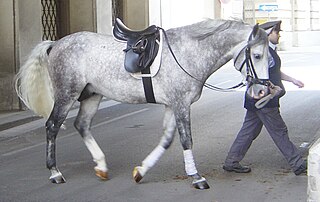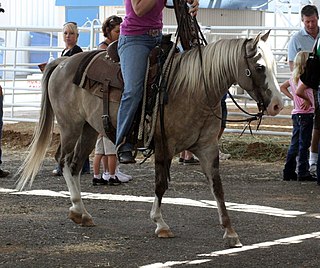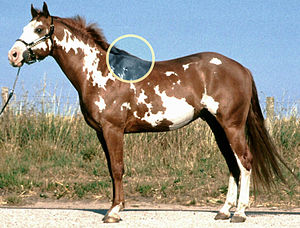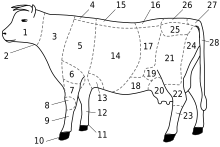
The trapezius is a large paired trapezoid-shaped surface muscle that extends longitudinally from the occipital bone to the lower thoracic vertebrae of the spine and laterally to the spine of the scapula. It moves the scapula and supports the arm.

The levator scapulae is a slender skeletal muscle situated at the back and side of the neck. It originates from the transverse processes of the four uppermost cervical vertebrae; it inserts onto the upper portion of the medial border of the scapula. It is innervated by the cervical nerves C3-C4, and frequently also by the dorsal scapular nerve. As the Latin name suggests, its main function is to lift the scapula.

English saddles are used to ride horses in English riding disciplines throughout the world. The discipline is not limited to England, the United Kingdom in general or other English-speaking countries. This style of saddle is used in all of the Olympic and International Federation for Equestrian Sports (FEI) equestrian disciplines, except for the newly approved FEI events of equestrian vaulting and reining. Most designs were specifically developed to allow the horse freedom of movement, whether jumping, running, or moving quickly across rugged, broken country with fences. Unlike the western saddle or Australian Stock Saddle, there is no horn or other design elements that stick out above the main tree of the saddle.

Cat anatomy comprises the anatomical studies of the visible parts of the body of a domestic cat, which are similar to those of other members of the genus Felis.

The Russian Don is a breed of horse developed in and named after the steppes region of Russia where the Don River flows. Utilized originally as cavalry horses for the Cossacks, they are currently used for under-saddle work and driving.

Equine conformation evaluates a horse's bone structure, musculature, and its body proportions in relation to each other. Undesirable conformation can limit the ability to perform a specific task. Although there are several faults with universal disadvantages, a horse's conformation is usually judged by what its intended use may be. Thus "form to function" is one of the first set of traits considered in judging conformation. A horse with poor form for a Grand Prix show jumper could have excellent conformation for a World Champion cutting horse, or to be a champion draft horse. Every horse has good and bad points of its conformation and many horses excel even with conformation faults.
Osteochondrosis is a family of orthopedic diseases of the joint that occur in children, adolescents and rapidly growing animals, particularly pigs, horses, dogs, and broiler chickens. They are characterized by interruption of the blood supply of a bone, in particular to the epiphysis, followed by localized bony necrosis, and later, regrowth of the bone. This disorder is defined as a focal disturbance of endochondral ossification and is regarded as having a multifactorial cause, so no one thing accounts for all aspects of this disease.

The Hunter division is a branch of horse show competition that is judged on the horse's performance, soundness and when indicated, conformation, suitability or manners. A "show hunter" is a horse that competes in this division.

Hunt seat is a style of forward seat riding commonly found in North American horse shows. Along with dressage, it is one of the two classic forms of English riding. The hunt seat is based on the tradition of fox hunting. Hunt seat competition in North America includes both flat and over fences for show hunters, which judge the horse's movement and form, and equitation classes, which judge the rider's ability both on the flat and over fences. The term hunt seat may also refer to any form of forward seat riding, including the kind seen in show jumping and eventing.

Dog anatomy comprises the anatomical studies of the visible parts of the body of a domestic dog. Details of structures vary tremendously from breed to breed, more than in any other animal species, wild or domesticated, as dogs are highly variable in height and weight. The smallest known adult dog was a Yorkshire Terrier that stood only 6.3 cm (2.5 in) at the shoulder, 9.5 cm (3.7 in) in length along the head and body, and weighed only 113 grams (4.0 oz). The heaviest dog was an English Mastiff named Zorba which weighed 314 pounds (142 kg). The tallest known adult dog is a Great Dane that stands 106.7 cm (42.0 in) at the shoulder.
Wobbler disease is a catchall term referring to several possible malformations of the cervical vertebrae that cause an unsteady (wobbly) gait and weakness in dogs and horses. A number of different conditions of the cervical (neck) spinal column cause similar clinical signs. These conditions may include malformation of the vertebrae, intervertebral disc protrusion, and disease of the interspinal ligaments, ligamenta flava, and articular facets of the vertebrae. Wobbler disease is also known as cervical vertebral instability, cervical spondylomyelopathy (CSM), and cervical vertebral malformation (CVM). In dogs, the disease is most common in large breeds, especially Great Danes and Doberman Pinschers. In horses, it is not linked to a particular breed, though it is most often seen in tall, race-bred horses of Thoroughbred or Standardbred ancestry. It is most likely inherited to at least some extent in dogs and horses.

Equine anatomy encompasses the gross and microscopic anatomy of horses, ponies and other equids, including donkeys, mules and zebras. While all anatomical features of equids are described in the same terms as for other animals by the International Committee on Veterinary Gross Anatomical Nomenclature in the book Nomina Anatomica Veterinaria, there are many horse-specific colloquial terms used by equestrians.

The back describes the area of horse anatomy where the saddle goes, and in popular usage extends to include the loin or lumbar region behind the thoracic vertebrae that also is crucial to a horse's weight-carrying ability. These two sections of the vertebral column beginning at the withers, the start of the thoracic vertebrae, and extend to the last lumbar vertebra. Because horses are ridden by humans, the strength and structure of the horse's back is critical to the animal's usefulness.
The term forehand refers to the front half of a horse's body.

The skeletal system of the horse has three major functions in the body. It protects vital organs, provides framework, and supports soft parts of the body. Horses typically have 205 bones. The pelvic limb typically contains 19 bones, while the thoracic limb contains 20 bones.

A pony is a type of small horse. Depending on the context, a pony may be a horse that is under a given approximate or exact height at the withers, or a small horse with a specific conformation and temperament. Compared to a larger horse, a pony may have a thicker coat, mane and tail, with proportionally shorter legs, a wider barrel, heavier bone, a thicker neck and a shorter, broader head. The word pony derives from the old French poulenet, meaning foal, a young, immature horse.
The Pinto Horse Association of America (PtHA) registers horses, utility horses, ponies and miniature horses of various pedigrees with certain kinds of pinto coat colors. The word pinto is Spanish for "paint." In general terms, pinto can apply to any horse marked with unpigmented pink-skinned, white-haired areas on its coat. The Pinto Horse Association of America provides the owners and riders of pintos with a show circuit and a breed organization. The primary requirement for PtHA registration is coat color; the pinto is not a true breed, but a color breed.

The Quarter Pony is a breed of pony that is similar to the American Quarter Horse. It stands up to 14.2 hands high and was developed from American Quarter Horse foundation bloodstock. The breed was originally developed from Quarter Horses that did not meet the American Quarter Horse Association's height requirement. It is bred to look like a small Quarter Horse, although the various registries also allow crosses with other breeds, including Paint horse, Appaloosa and Pony of the Americas, all stock types. It is one of the most versatile horse breeds there are. There are three registries for the Quarter Pony, all with slightly different registration requirements. The first registry was begun in 1964, and two more were started in the 1970s. The breed is used today in a variety of Western and English riding disciplines.

The vertebral column, also known as the backbone or spine, is part of the axial skeleton. The vertebral column is the defining characteristic of a vertebrate in which the notochord found in all chordates has been replaced by a segmented series of bone: vertebrae separated by intervertebral discs. Individual vertebrae are named according to their region and position, and can be used as anatomical landmarks in order to guide procedures such as lumbar punctures. The vertebral column houses the spinal canal, a cavity that encloses and protects the spinal cord.

The spinal column, a defining synapomorphy shared by nearly all vertebrates, is a moderately flexible series of vertebrae, each constituting a characteristic irregular bone whose complex structure is composed primarily of bone, and secondarily of hyaline cartilage. They show variation in the proportion contributed by these two tissue types; such variations correlate on one hand with the cerebral/caudal rank, and on the other with phylogenetic differences among the vertebrate taxa.

















